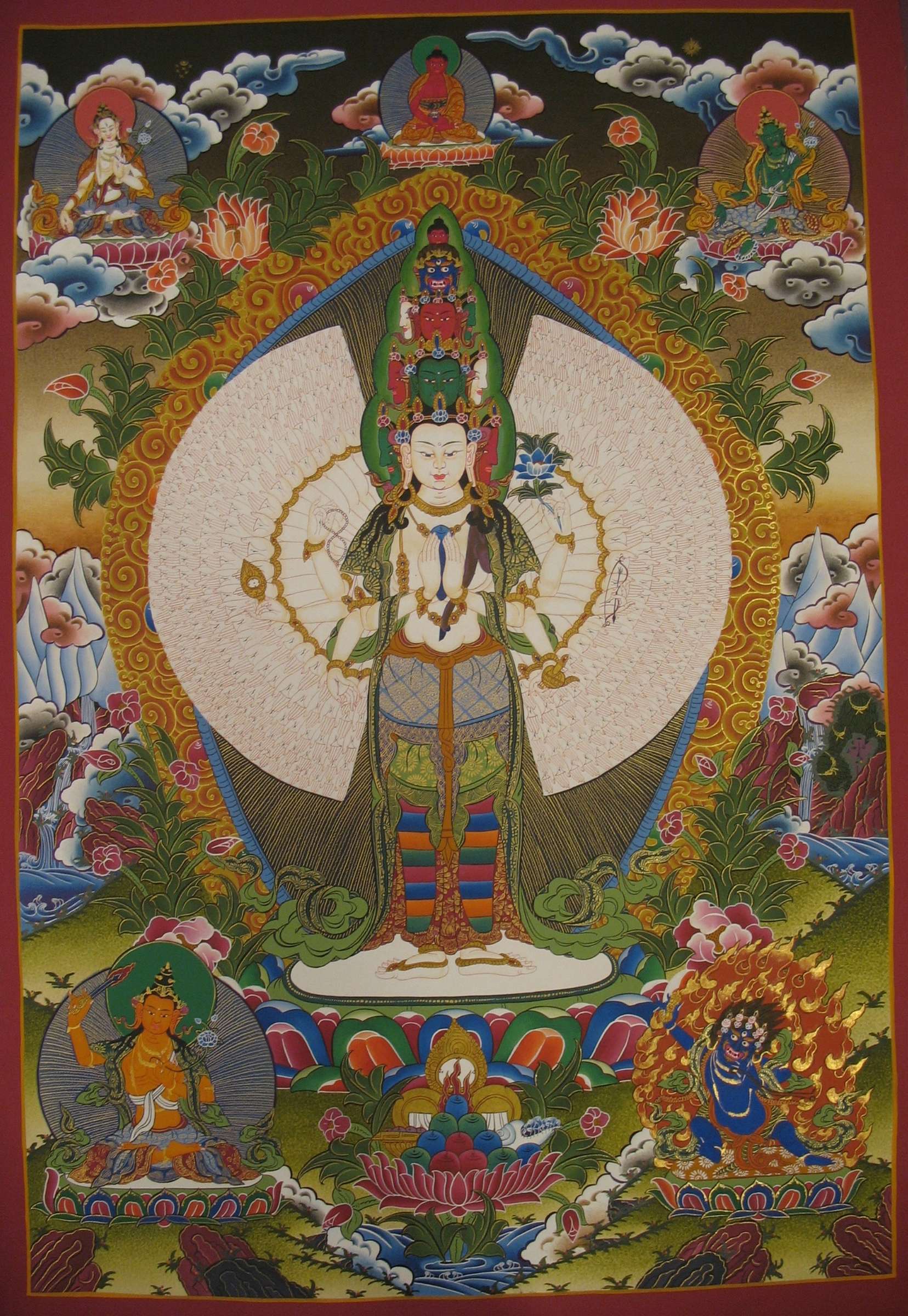

Lokeshvara with Green Tara
Lokeshvara with Green Tara is handpainted on cotton canvas. The images of Amoghpasa can be found in Java, China, and Japan. Lokeshvara is a multi-armed form of Avalokiteshvara that seems to have been popular in Nepal since the Middle ages. The name suggests that he is the lord of the world with infallible noose which leads suffering sentient beings to enlightenment.
Lokeshvara presented at the center of the thangka. Manjushree is presented at the left down corner of the Lokeshvara in the thangka. Vajrapani is presented at the right down corner of the Lokeshvara in the thangka. White tara is presented at the top left corner of the Lokeshvara in the thangka. Amitabha Buddha is presented at the top of the Lokeshvara in the thangka. Green Tara is presented at the top right corner of the Lokeshvar in the thangka.
Iconography of Lokeshvara
Lokeshvara is the mystery in the center of the world lotus. All his limbs are white. He has one face and wears the saffron dress.
He is wearing an antelope skin symbolizing that he is extremely compassionate to suffering sentient beings. He has eight hands, the right showing the gesture of fearlessness and the boon granting gesture. He is holding the noose and the string of beads, the left holding a trident, a scripture, a white lotus, and a water pot.
Iconography of Manjushree
Manjushree is presented at the left down corner of the theLokeshvara in the thangka. Manjushree is the Bodhisattva who holds the flaming sword of enlightenment, by his left hand in a warning hand gesture in the left hand representing his realization of wisdom to cut through ignorance & wrong view. His right hand depicted in teaching holds the stem of a Blue Lotus flower upon which rests the Book (Pustaka) of Perfection of Transcendental Wisdom.
Mantra of Manjushree
The mantra of Manjushree is Om A Ra Pa Ca Na Dhih.
Iconography of Vajrapani
Vajrapani is presented at the right down corner of the Lokeshvara in the thangka. Vajrapaṇi is one of the earliest bodhisattvas of Mahayana Buddhism. He is the protector and guide of the Buddha and rose to symbolize the Buddha's power.
Vajrapani is pictured dancing wildly within a halo of flames which represents transformation.
He holds a vajra (thunderbolt) in his right hand which emphasizes the power to cut through the darkness of delusion. Vajrapani looks wrathful, but as a representation of the enlightened mind. He is completely free from hatred.
Mantra of Vajrapani
The mantra of Vajrapani is om vajrapani hum phat.
Iconography of White Tara
White tara is presented at the top left corner of the Lokeshvara in the thangka. White Tara's embodiment of peace directed through loving compassion. From her serenity, she lends grace and dignity to situations and encourages the good to arise in all circumstances and situations.
The extra eye on her forehead, on the palms of her hands & the soles of her feet, represent her ability to see and understand the sufferings of all beings & her omniscient compassion toward the suffering.
Mantra of White Tara
The mantra of White Tara is Om Tare Tuttare Ture Mama Ayur Pune Gyana Puntin Kuru Swoha.
Iconography of Amitabha buddha
Amitabha Buddha is presented at the top of the Lokeshvara in the thangka. Amitabha is head of the Lotus Family, one of the oldest & significant of the Five Buddha Families. This family represents love, purity, compassion & peace. Amitabha Purelandis a place of infinite bliss & boundless light.
Amitabha Buddha is also one of the five Tathagatas representing the wisdoAmitabha Buddha is also one of the five Tathagatas representing the wisdom of discriminating awareness. Amitabha Buddha is red in color. He is represented in the stupa facing to the west. He rides on a peacock symbolizing that he can take away the suffering of others just as the peacock eats poisonous plants and yet his tail shines forth.
Mantra of Amitabha Buddha
The mantra of Amitabha Buddha is Om ami dewa hr.
Iconography of Green tara
Green Tara is presented at the top right corner of the Lokeshvar in the thangka. She is shown with a benevolent countenance seated upon a white moon disk which is associated with special restorative nectar associated with the naval chakra center. In Buddhists, the moon symbolizes the wisdom aspect which when coupled with compassion leads to Sakyamuni Buddha's enlightenment. Her right hand is gracefully lowered in Varada mudra, the boon-granting gesture.
Green Tara's special lotus is the blue lotus or 'night lotus' which she bears in both hands. The word Utpala means to 'burst open'. Her left-hand holds a stem with an open blooming flower and an unopened bud. The bent lower part of the stem represents the root.
The open blossom represents the present and also the present Buddha; the bud represents the future and also Buddhas yet to be born. The future here also refers to a safe journey's end and a future well being. Her right-hand wisdom hand is in the gesture of giving refuge.
The third finger touches the thumb to create a circle representing the union of wisdom and compassion, and the three extended fingers symbolize the Three Jewels of Buddhism a. The Buddha State b. The Body of teachings c.
The Principles of the Universe The same hand holds the stem of a blue lotus representing her willingness to assist. The closed blossom in her right hand represents the past and also the Buddhas of the past. Green Tara is shown in a place of paradise called Khadiravani where Tara dwells. Khadiravani is described as a great mountain kingdom with many trees, flowers, and animals rainbow tails emanate from her outer aureole. The crescent moon and sun symbolize the union of male and female ubiquitous in Tantric art.
Mantra of Green Tara
The mantra of Green Tara is om tare tuttare ture soha.












